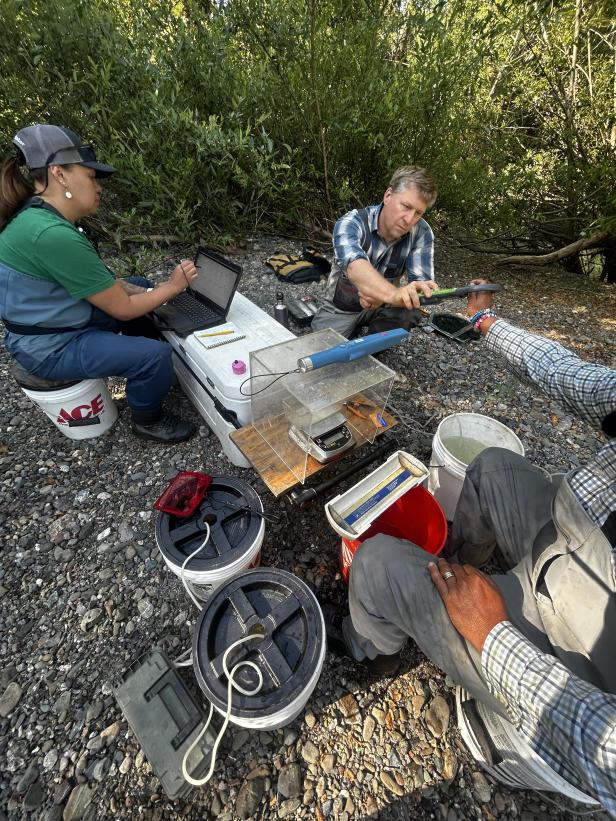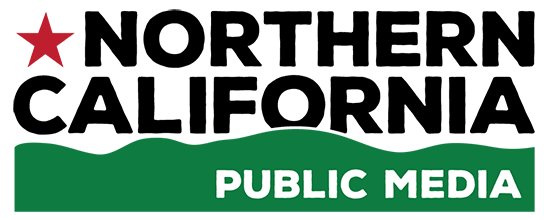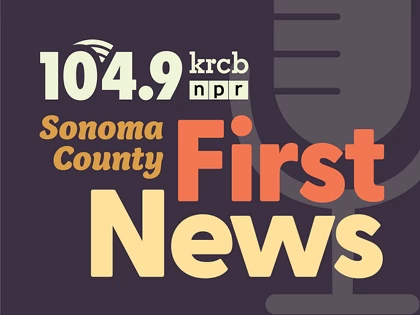 photo credit: photo credit text goes here
photo credit: photo credit text goes hereSonoma Water fish and wildlife tech Sanoe Deaver {left) tallies each fish's species, lifestage, length, weight, and tag status from Justin Smith (center) and Miguel O'Huerta's survey.
Every summer for the past 20 years, biologists with Sonoma Water don their waders and boots, not to catch fish but to count them.
Seven days a week, at five different put-ins, Sonoma Water biologists Miguel O’Huerta and Sanoe Deaver wade into the cold Russian River to scoop small fish from traps laid in late spring. One-by-one they tally each salmonid — fish in the salmon family.
“Coho smolt. Yeah, gorgeous. This is going to be at 95,” O’Huerta called out to Deaver who logged the data. She asked if he’d scanned the fish yet. “Yep, no snout. Yep, no scan,” O’Huerta responded. “And this is going to be at 9.7 and it's going downstream. Beautiful.”
First they record the species, counting only steelhead, chinook and coho. Then they record the lifestage. “Smolts” are juveniles swimming toward the ocean for the very first time.
The biologists measure length and weight, and then they scan each fish, once to check for an implant from the Lake Sonoma hatchery, and another for a Sonoma Water tag. If it’s a chinook smolt, there’s one more step before release.
“So we take a sub-sample of fish each day, and we apply an upper caudal clip to them, so that's on the upper lobe of the tail fin,” said Justin Smith, fisheries biologist with Sonoma Water. “And then we put those fish upstream of our trap, and we recapture a percentage of those fish, and then we use that to estimate the trap efficiency, so that we can take our unmarked fish and expand it to a daily trap or a daily catch estimate, and then you can get a population estimate for the end of the season that way.”
Smith said a reliable population estimate is the point. He knows that salmonid populations aren’t what they used to be. So does Don McEnhill. The deputy director of the Russian Riverkeeper spent his childhood summers on Fitch Mountain.
“When I was younger, growing up in the ‘60s, we had 70,000 salmon or steelhead. Today we have, you know, in a good year we might see 5,000 fish,” McEnhill said.
But water quality has improved. It’s cleaner, with less sewage runoff, less pollution. So why haven’t the fish bounced back?
According to Smith, cleanliness is only part of the equation. It’s also about speed, something that shifted drastically after Lakes Mendocino and Sonoma were built.
Before, water flowed at rates of 10 to 20 cubic feet per second in the summer. Or sometimes it stopped flowing at all, leaving what Smith calls discontinuous pools. Now the flows are a consistent 70 to 80 cubic feet per second.
“The flows are higher and augmented from these reservoir releases. So the velocities are very high in the stream channel, and they're not the best especially for coho, which need very still water,” Smith said. “They need cold, deep and slow moving water. So Sonoma Water and the Army Corps have built a lot of habitat enhancements along Dry Creek for a place for those fish to go.”
McEnhill said he appreciates Sonoma Water and the Army Corps’ improvements, mandated by the National Marine Fisheries Service, to protect the endangered salmon. But he also said those agencies can’t fix all the habitat problems.
“In the last 50 some-odd years, we have dramatically shrunken the area the river occupies, especially during flood events. You know, we've removed 80% of the area where the river used to exist. So we've grossly diminished the size of the river, and most importantly, its connection with the floodplains. Gravel mining and our dams — which are critical — have essentially dropped the river bed 25 feet,” McEnhill said. “And at the same time, development has encroached on the river channel, so we have a deep, narrow ditch instead of a wide river during the winter months when it floods. And that has simplified the river in a way that's really cost us a lot of our ecology.”
McEnhill said the changes also cost the salmonids their food source. Floodplains are like nurseries for the bugs and micro-crustaceans these fish love to eat. The insects should be laying eggs on the dry plains which, come winter rains, allow for massive hatches that can support an abundance of salmon.
Restoring the floodplains is what McEnhill called the single best thing we could do for the fish. To that end, the Russian Riverkeeper is working with the California Coastal Conservancy, the state Department of Fish and Wildlife, and the mining companies the Riverkeeper “used to fight with.”
He said there are 14 gravel pits that could be turned into floodplains — or food production sites for fish.
“I think, you know, both with what the water agency is doing and what we hope to achieve combined, hopefully will really, really start to improve our salmon populations,” McEnhill said.
Smith said he is hopeful too, because of how Sonoma Water responded to the federal mandate. He said in other places, the local water agency might fight with national fish regulators “or be resistant in starting some of the monitoring programs. Where, here, we’re trying to do the best we can to manage the resources for these fish.”
Smith is also optimistic because of the results he sees in the traps.
“When we started this trap, we didn't see any wild coho, you know, our first couple years. And it's been slowly that we've been getting more and more,” he said. “I think this is our fourth best year for wild coho at Dry Creek, and it's our best year for coho at Willow Creek this year."

 Live Radio
Live Radio




